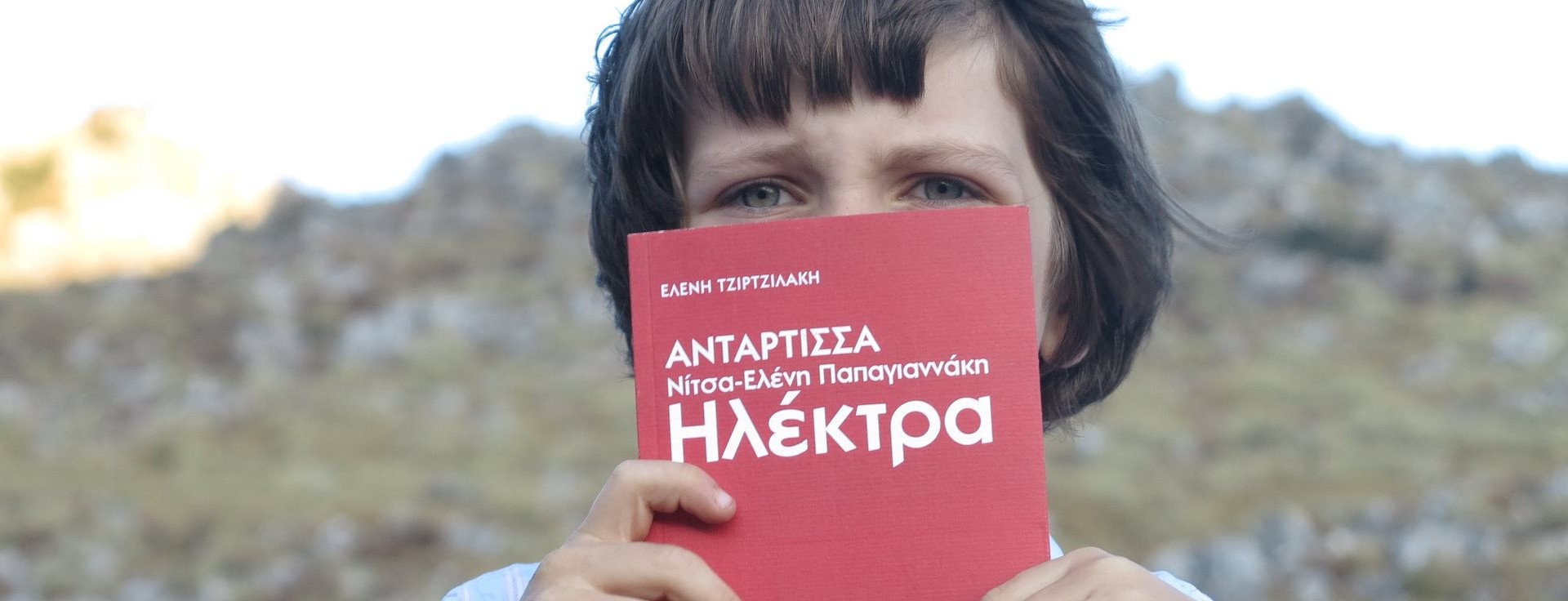A visit to the place. Life must change.
On Revolution.
On the afternoon of September 12th, 2015 a group of women, men and two children (14 people in total) headed to the mountain village Kallikratis, situated on a plateau, mainly inhabited during the summer, with trees, sheep and goats, towards the location Sideroporti, on the Mountain. At the place where, on April 18, 1949, as it seems from the press of that period, at 3.30 in the afternoon during a conflict , partisan Nitsa-Eleni Papayiannakis, called Electra, was killed along with Athena Chandapakis and the rebels: Giorgos Manouselis (group leader originated from Kallikratis village), Andreas Kourkoumelis, Sotiris Psarrakis, Georgis Christou, Vasilis Vlassis (Lycurgus). Giorgos Miaoulis, although survived the conflict, he was later killed.
In the wild mountains of the area, among thorns and sharp stones, wildflowers had sprung up. The visit to the mountain, although Nitsa Eleni Papayiannakis, called Electra, was my mother’s sister and I have her name, belongs to the collective memory of the impossible Revolution which was the Civil War.
The location is close to the steep road that leads from Kapsodasos and Patsiano to Kallikratis village. Kallikratis canyon is located almost parallel. It is likely that the rebel team had chosen this location during this phase of the revolution, because it was near the village from which it could be supported. We are in 1949 when rebels had suffered great losses. The same happened in Crete, after the battle which took place at Samaria Canyon in June 1948. Afterwards, in order to block them and weaken them, the zone of the mountainous region of the prefecture of Chania was declared forbidden, while villages were completely evacuated.
We were taken to the place by a friend who lives in Kallikratis village, who took into account the testimonies of the villagers.
At first we arrived at the hill where, according to the testimonies, the rebel who was guarding the area was killed. It is said that someone from the village betrayed them and that’s how they found the location. Then, we walked through stones and thorns among the wild terrain and we reached the cave where they used to sleep. Afterwards, we went to the place where the battle took place according to the testimonies, which, as written in the press of that period, lasted two hours. We remained silent in order to honor them and reflect on them.
There, among the stones, we placed the ceramic-gift which was made in Vathi of Sifnos with the word FREEDOM written on it, a word with great significance then as well as now. We read the poem “In Solonos Street. A very cold evening, the name of the woman with the army boots was born, who got killed in a battle on the mountain…”. A text was also read out about the refugees and their stories by the team that had come from the Social Center/Immigrants’ place (Steki Metanaston) at Chania. The book under the title “PARTISAN Nitsa – Eleni Papayiannakis Electra” which was written especially for the occasion and included the collected material, was given to those who were present.
Then, we went to the place where they were buried. A wild, inhospitable and foreign place.
Afterwards, we ate and drank all together in the kafeneio and we talked about the past and the present.
In the village, the memories of the event are intense and raw, they find it hard to talk about it. The story has not yet been said publicly.
Adriani from Kapsodasos, a fighter’s niece, told us that her uncle had the desire to erect a stone seat at the site bearing the engraved names of the rebels, where the passersby would sit and think about the rebels and their struggle.
The search regarding the events of the Civil War and history itself, in books of rebels who survived, of researchers, of historians, the archival research in archives in Chania (work in progress), the testimonies of relatives and rebel survivors of the Mountain, were important for the publication of the issue “Partisan Nitsa-Eleni Papayiannakis Electra”, Athens 2015.
A sense of Utopia accompanied us during the days of the visit, coming from the past of this battle that took place on the Mountain and was associated with birds, animals, flowers, the landscape of Kallikratis and the surrounding area. During the visit it is important to detect the civil war landscape and the landscape as a place of revolution, feelings, and reflections. Nature here is mighty and ecstatic. It is obvious that it participated in the human excess and the human drama as well.
Managing the material aims to attribute to the collective through the recollection of the silent past, and seeks participation. Today, the testimonies of the inhabitants of the surrounding villages of Kallikratis, Kapsodasos, Patsianos, testimonies of people who heard the story, but did not experience it, were often contradictory expressing exactly this civil war landscape that has not been detected. This approach seeks to detect through steps how the past penetrates the collective body.
The mapping of mountain paths, which will follow, will detect the connection of the rebels’ body with this landscape.
The visit to the mountain, the connection with the life of the rebels there, leads to radical changes regarding our present life in the city, leads to thoughts about the Revolution.
Eleni Tzirtzilaki nomadikiarxitektoniki.net
I would like to thank Stefanos Chandelis for the companionship during the visit on the Mountain, for the conduct of the visit. Theodoris Stephanopoulos and Despina Stasinopoulou who contributed to making this book a reality. I would also like to thank everyone who participated in the visit.
Recording of the event, Stefanos Chandelis, PAP

